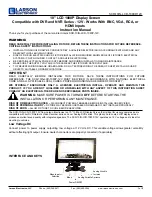
14
2. Projecting an Image (Basic Operation)
❷
Connecting Your Computer/Connecting the supplied Power
Cord
NOTE:
• Install a lens before performing the following steps. (
→
page
1. Connect your computer to the projector.
This section will show you a basic connection to a computer. For information about other connections, see “(2)
Making Connections” on page
Connect the computer cable (VGA) between the projector’s COMPUTER 1 IN connector and the computer’s port
(mini D-Sub 15 Pin). Turn two thumb screws of both connectors to fix the computer cable (VGA).
2. Connect the supplied power cord to the projector.
WARNING: TO PREVENT FIRE OR SHOCK, DO NOT EXPOSE THIS UNIT TO RAIN OR MOISTURE.
DO NOT USE THIS UNIT’S PLUG WITH AN EXTENSION CORD OR IN AN OUTLET UNLESS ALL THE PRONGS
CAN BE FULLY INSERTED.
Important Information:
• When plugging in or unplugging the supplied power cord, make sure that the main power switch is pushed to
the off [O] position. Failure to do so may cause damage to the projector.
• Do not use a three-phase power supply. Doing so may cause malfunction.
First connect the supplied power cord’s three-pin plug to the AC IN of the projector, and then connect the other
plug of the supplied power cord in the wall outlet.
COMPUTER 1 IN
Make sure that the prongs are fully inserted into
both the AC IN and the wall outlet.
Main power switch
To wall outlet
NOTE (for North America only)
• The model distributed in North America comes with two different types of power cords: one for 120V and the other for 200V.
Use the power cord suitable for the voltage being used.
CAUTION:
Parts of the projector may become temporarily heated if the projector is turned off with the POWER button or if the
AC power supply is disconnected during normal projector operation.
Use caution when picking up the projector.
Содержание NP-PX700W2
Страница 252: ... NEC Display Solutions Ltd 2014 7N952052 ...
















































